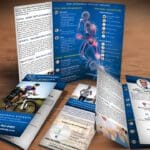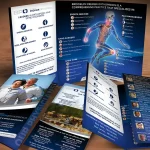Inclusive web design is a crucial aspect of creating a website that is accessible to all users, regardless of their abilities or disabilities. It involves designing and developing websites in a way that ensures equal access and usability for everyone. In this blog post, we will explore the importance of inclusive web design and its impact on individuals with disabilities. We will also discuss the key elements of accessible web design, designing for different types of disabilities, user testing for accessibility, the role of assistive technologies, common web accessibility barriers and how to overcome them, the legal requirements for web accessibility, best practices for creating inclusive websites, and the business benefits of inclusive web design.
Key Takeaways
- Inclusivity in web design is crucial for ensuring equal access to information and services for all users.
- Inaccessible websites can have a significant negative impact on individuals with disabilities, limiting their ability to participate fully in society.
- Key elements of accessible web design include clear and consistent navigation, proper use of headings and labels, and providing alternative text for images and multimedia.
- Designing for different types of disabilities requires understanding the unique needs and challenges of each group, such as visual impairments, hearing impairments, and motor disabilities.
- User testing for accessibility is essential for identifying and addressing barriers to access, and assistive technologies can play a critical role in improving accessibility for users with disabilities.
Understanding the Importance of Inclusivity in Web Design
Inclusivity in web design refers to the practice of creating websites that can be accessed and used by all individuals, regardless of their abilities or disabilities. It is important because it ensures that everyone has equal access to information and services on the internet. Inclusive web design considers the diverse needs and preferences of users and aims to provide a seamless user experience for all.
Inclusivity in web design benefits both users and businesses. For users with disabilities, an inclusive website allows them to navigate, interact with, and consume content on the internet without barriers. It empowers them to participate fully in online activities, such as shopping, banking, socializing, and accessing information. Inclusive web design also benefits businesses by expanding their customer base. When websites are accessible to all users, businesses can reach a larger audience and increase their potential customer pool. Additionally, inclusive web design improves user experience for all users, leading to increased customer satisfaction and loyalty.
The Impact of Inaccessible Websites on Individuals with Disabilities
Inaccessible websites can have a significant impact on individuals with disabilities. When websites are not designed with accessibility in mind, individuals with disabilities may face barriers that prevent them from accessing information or using online services. This can lead to feelings of exclusion, frustration, and a sense of being left behind in the digital age.
Statistics show that a large number of people are affected by inaccessible websites. According to the World Health Organization, approximately 15% of the world’s population lives with some form of disability. This means that millions of individuals are potentially unable to access and use websites that are not designed with accessibility in mind.
Real-life examples highlight the impact of inaccessible websites on individuals with disabilities. For instance, a person with visual impairments may struggle to navigate a website that lacks proper headings, alt text for images, or sufficient color contrast. This can make it difficult for them to find the information they need or complete tasks on the website. Similarly, a person with mobility impairments may encounter difficulties if a website is not designed to be keyboard accessible or if it has complex navigation structures. These barriers can prevent individuals with disabilities from fully participating in online activities and accessing essential services.
Key Elements of Accessible Web Design
Accessible web design involves incorporating key elements that ensure equal access and usability for all users. These elements include:
1. Proper use of headings and structure: Headings provide a hierarchical structure to web content, making it easier for users to navigate and understand the information on a webpage. Properly structured headings also benefit users who rely on screen readers or other assistive technologies to access content.
2. Alternative text for images: Alt text is a description of an image that is read aloud by screen readers. It allows individuals with visual impairments to understand the content and context of an image.
3. Sufficient color contrast: Color contrast is important for users with visual impairments or color blindness. It ensures that text and other elements are easily distinguishable from the background, making them readable for all users.
4. Keyboard accessibility: Websites should be designed to be navigable using only a keyboard, as some users may have difficulty using a mouse or other pointing devices. This includes providing keyboard shortcuts, focus indicators, and ensuring that all interactive elements are accessible via keyboard navigation.
5. Captions and transcripts for multimedia: Captions and transcripts are essential for individuals with hearing impairments or those who prefer to consume content without audio. They provide a text-based alternative to audio content, allowing users to understand the information being conveyed.
It is important to consider accessibility from the beginning of the design process. By incorporating these key elements into the initial design, web designers can ensure that accessibility is an integral part of the website’s structure and functionality.
Designing for Different Types of Disabilities
Web designers need to consider the different types of disabilities that can affect web users and design their websites accordingly. Some common types of disabilities include:
1. Visual impairments: Individuals with visual impairments may have difficulty seeing or perceiving visual content on a website. Designing for visual impairments involves using proper headings and structure, providing alt text for images, ensuring sufficient color contrast, and offering resizable text options.
2. Hearing impairments: Individuals with hearing impairments may have difficulty hearing audio content on a website. Designing for hearing impairments involves providing captions or transcripts for multimedia content and ensuring that important information is not conveyed solely through audio.
3. Motor impairments: Individuals with motor impairments may have difficulty using a mouse or other pointing devices. Designing for motor impairments involves making websites keyboard accessible, providing large clickable areas, and minimizing the need for precise mouse movements.
4. Cognitive impairments: Individuals with cognitive impairments may have difficulty understanding complex information or navigating complex websites. Designing for cognitive impairments involves using clear and concise language, organizing information in a logical manner, and minimizing distractions.
By considering the specific needs of individuals with different types of disabilities, web designers can create websites that are accessible and usable for all users.
How to Conduct User Testing for Accessibility
User testing for accessibility is an essential part of the web design process. It involves evaluating a website’s accessibility by observing individuals with disabilities as they interact with the website and identifying any barriers or usability issues they encounter. User testing helps identify areas for improvement and ensures that the website meets the needs of all users.
To conduct user testing for accessibility, web designers can follow these steps:
1. Recruit participants with disabilities: Identify individuals with different types of disabilities who can provide valuable insights into the accessibility of the website. This can be done through disability organizations, online communities, or by reaching out to individuals directly.
2. Define test scenarios: Create specific tasks or scenarios that participants will be asked to complete on the website. These tasks should cover a range of functionalities and interactions to ensure comprehensive testing.
3. Observe and document participant interactions: Watch as participants navigate the website and complete the defined tasks. Take note of any difficulties, barriers, or usability issues they encounter.
4. Collect feedback and insights: After each testing session, interview participants to gather their feedback and insights on their experience with the website. Ask open-ended questions to encourage participants to share their thoughts and suggestions for improvement.
5. Analyze findings and make improvements: Analyze the data collected from user testing sessions and identify common patterns or issues. Use this information to make necessary improvements to the website’s accessibility.
There are various tools and resources available for conducting user testing for accessibility, such as screen readers, keyboard emulators, and automated testing tools. These tools can help simulate the experience of individuals with disabilities and identify potential accessibility issues.
The Role of Assistive Technologies in Web Accessibility
Assistive technologies play a crucial role in enabling individuals with disabilities to access and use websites. Assistive technologies are software or hardware devices that help individuals with disabilities interact with digital content. They bridge the gap between the user and the website, providing alternative ways to perceive, navigate, and interact with web content.
Some examples of assistive technologies include:
1. Screen readers: Screen readers are software programs that read aloud the content of a website to individuals with visual impairments. They convert text into synthesized speech or braille output, allowing users to navigate and consume web content.
2. Screen magnifiers: Screen magnifiers are software or hardware devices that enlarge the content on a screen, making it easier for individuals with visual impairments to read and interact with websites.
3. Speech recognition software: Speech recognition software allows individuals with motor impairments or those who have difficulty typing to control a computer or interact with a website using voice commands.
4. Alternative input devices: Alternative input devices, such as mouth sticks or eye-tracking devices, enable individuals with motor impairments to navigate and interact with websites using alternative methods.
Assistive technologies work in conjunction with accessible web design to provide individuals with disabilities equal access to web content. Web designers should consider how their websites can be compatible with assistive technologies and ensure that the necessary accessibility features are in place.
Common Web Accessibility Barriers and How to Overcome Them
There are several common web accessibility barriers that can prevent individuals with disabilities from accessing and using websites. These barriers include:
1. Lack of proper headings and structure: Websites that lack proper headings and structure make it difficult for users, especially those who rely on screen readers, to navigate and understand the content. To overcome this barrier, web designers should use semantic HTML markup and ensure that headings are used in a logical and hierarchical manner.
2. Insufficient color contrast: Websites with insufficient color contrast can make it difficult for users with visual impairments or color blindness to read the text or distinguish between different elements. To overcome this barrier, web designers should use color contrast tools to ensure that text and other elements have sufficient contrast against the background.
3. Inaccessible forms and input fields: Forms and input fields that are not properly labeled or do not have clear instructions can be challenging for users with disabilities to complete. To overcome this barrier, web designers should provide clear and concise labels for form fields, use error messages that are easy to understand, and ensure that forms can be navigated and completed using only a keyboard.
4. Lack of alternative text for images: Images without alternative text make it impossible for individuals with visual impairments to understand the content and context of the image. To overcome this barrier, web designers should provide descriptive alt text for all images on the website.
5. Complex navigation structures: Websites with complex navigation structures can be confusing and overwhelming for users with disabilities. To overcome this barrier, web designers should ensure that navigation menus are clear, consistent, and easy to understand. They should also provide skip navigation links to allow users to bypass repetitive navigation elements.
By addressing these common web accessibility barriers, web designers can create websites that are accessible and usable for all users.
The Legal Requirements for Web Accessibility
Web accessibility is not just a best practice; it is also a legal requirement in many countries. Laws and regulations have been put in place to ensure that websites are accessible to individuals with disabilities. These laws vary from country to country but generally aim to promote equal access to information and services on the internet.
In the United States, the Americans with Disabilities Act (ADA) prohibits discrimination against individuals with disabilities in places of public accommodation, which includes websites. The Web Content Accessibility Guidelines (WCAG) 2.0, developed by the World Wide Web Consortium (W3C), are widely recognized as the international standard for web accessibility. Many countries have adopted or referenced WCAG as part of their accessibility laws or regulations.
In recent years, there has been an increase in legal cases related to web accessibility. Businesses and organizations have faced lawsuits and legal action for having inaccessible websites. It is important for businesses and web designers to be aware of the legal requirements for web accessibility in their respective countries and ensure that their websites comply with these requirements.
Best Practices for Creating Inclusive Websites
Creating inclusive websites involves following best practices that prioritize accessibility and usability for all users. Some best practices for creating inclusive websites include:
1. Use semantic HTML markup: Semantic HTML markup ensures that the structure and content of a website are properly conveyed to all users, including those who rely on assistive technologies.
2. Provide clear and concise content: Use plain language and avoid jargon or complex terminology. Break down information into digestible chunks and use headings, lists, and other formatting techniques to make content scannable.
3. Ensure keyboard accessibility: Design websites to be navigable using only a keyboard. This includes providing keyboard shortcuts, focus indicators, and ensuring that all interactive elements can be accessed via keyboard navigation.
4. Use descriptive alt text for images: Provide alternative text descriptions for all images on the website. The alt text should accurately describe the content and context of the image.
5. Ensure color contrast: Use color contrast tools to ensure that text and other elements have sufficient contrast against the background. This ensures readability for users with visual impairments or color blindness.
6. Provide captions and transcripts for multimedia: Include captions or transcripts for audio and video content to make it accessible to individuals with hearing impairments or those who prefer to consume content without audio.
7. Test with assistive technologies: Test the website using assistive technologies, such as screen readers or keyboard emulators, to ensure compatibility and identify any accessibility issues.
By implementing these best practices, web designers can create websites that are accessible, usable, and inclusive for all users.
The Business Benefits of Inclusive Web Design
Inclusive web design not only benefits individuals with disabilities but also offers numerous advantages for businesses. By prioritizing accessibility, businesses can improve user experience, increase customer satisfaction, and ultimately drive revenue. Some of the business benefits of inclusive web design include:
1. Expanded customer base: When websites are accessible to all users, businesses can reach a larger audience and tap into new markets. By making their websites inclusive, businesses can attract individuals with disabilities as customers and increase their potential customer pool.
2. Improved user experience: Inclusive web design improves user experience for all users, not just those with disabilities. Websites that are easy to navigate, have clear content, and provide a seamless user experience are more likely to attract and retain customers.
3. Increased customer loyalty: When businesses prioritize accessibility and create inclusive websites, they demonstrate a commitment to inclusivity and equal access. This can foster customer loyalty and build trust with users who value accessibility.
4. Compliance with legal requirements: By ensuring that their websites comply with legal requirements for web accessibility, businesses can avoid potential lawsuits and legal action. Compliance with accessibility laws and regulations is not only a legal obligation but also a responsible business practice.
5. Positive brand image: Inclusive web design can enhance a business’s brand image and reputation. By demonstrating a commitment to accessibility, businesses can position themselves as socially responsible and inclusive organizations.
Inclusive web design is essential for creating websites that are accessible and usable for all users, regardless of their abilities or disabilities. It ensures equal access to information and services on the internet and benefits both users and businesses. By understanding the importance of inclusive web design and implementing it in website development, businesses can reach a wider audience and improve user satisfaction. Inclusive web design also aligns with legal requirements and standards, such as the Web Content Accessibility Guidelines (WCAG), which promote equal access to digital content. Additionally, inclusive web design can enhance search engine optimization (SEO) efforts, as search engines prioritize websites that are accessible and user-friendly. Overall, investing in inclusive web design is not only a moral imperative but also a strategic decision that can lead to increased user engagement, customer loyalty, and business growth.
If you’re interested in accessible web design, you may also find this article on “The Importance of Logo Questionnaires in Web Design” helpful. It discusses how logo questionnaires can play a crucial role in creating a visually appealing and accessible website. Check it out here.
FAQs
What is accessible web design?
Accessible web design refers to the practice of designing websites that can be used by people with disabilities, including visual, auditory, physical, and cognitive impairments.
Why is accessible web design important?
Accessible web design is important because it ensures that everyone, regardless of their abilities, can access and use websites. It also helps websites comply with legal requirements and can improve search engine optimization.
What are some examples of accessible web design features?
Some examples of accessible web design features include alt text for images, captions for videos, keyboard navigation, high color contrast, and clear and concise language.
What are some benefits of accessible web design?
Some benefits of accessible web design include increased usability for all users, improved search engine optimization, compliance with legal requirements, and a larger potential audience for websites.
What are some common accessibility barriers on websites?
Some common accessibility barriers on websites include lack of alt text for images, videos without captions, poor color contrast, small font sizes, and complex navigation structures.
How can I make my website more accessible?
There are many ways to make a website more accessible, including using descriptive alt text for images, providing captions for videos, using high color contrast, using clear and concise language, and ensuring keyboard navigation is possible. It is also important to test the website with assistive technologies and to get feedback from users with disabilities.















Thanks for sharing these web design strategies! The top web design company Phoenix seems to have mastered these elements perfectly.